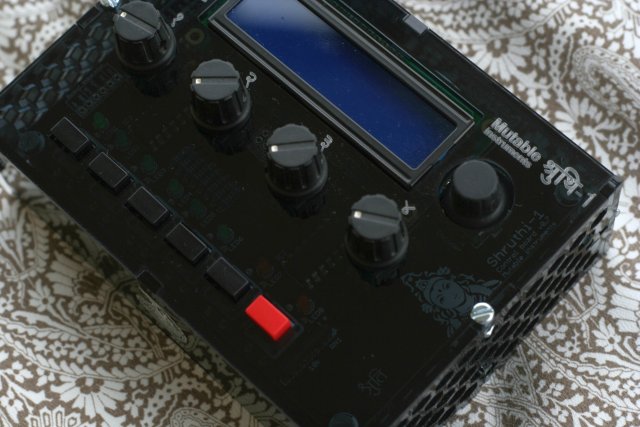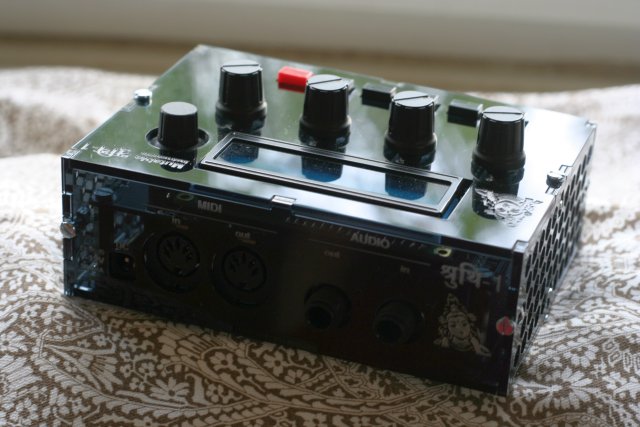Shruthi-1 Mutable Instruments
27 février 2011 - 2 commentaires
Shruthi-1 est un micro synthé livré en kit et à monter soi même.
Conçu par http://mutable-instruments.net/ il propose énormément d'options (voir en bas d'article pour les détails) et est complètement ouvert aussi bien au niveau de l'architecture matérielle que du logiciel, qui est libre.
Voilà le kit que l'on reçoit : 
La première résistance est soudée : 
En suivant les instructions pas à pas on monte le synthé très facilement, il m'a fallu deux demi-journées : 
Inspection des soudures à la loupe : 
Il vaut mieux être très méthodique et classer les composants par étape de construction : 
Le moment magique où le shruthi s'allume pour la première fois :
Un peu de son, réalisé en live uniquement avec le shruti ( + un peu de delay). Le shruti sort une onde carrée + un vowel (algorithme à base de formants imitant la voix) séquencés par le séquenceur interne, ça sonne un peu façon didjeridoo :
Encore un peu de travail, je compte concevoir la façade moi même, y ajouter un joystick, récupéré sur un module Doepfer pour piloter CV1 et 2, j'ajouterai aussi deux potentiomètres pour piloter les CV3 et CV4 : 
Je viens de commander tout ce qu'il faut chez musikding, puis je finaliserai la façade, et je terminerai l'assemblage avec du bois
à suivre...
Digital/analog hybrid monosynth.
2 digital oscillators
- band-limited sawtooth with adjustable phase
- band-limited square wave with adjustable pulse-width
- band-limited triangle wave with adjustable waveshapping
- phase-distortion emulation of a low-pass filtered sawtooth (casio CZ-101)
- phase-distortion emulation of a low-pass filtered sawtooth with high resonance (casio CZ-101)
- phase-distortion emulation of a low-pass filtered sawtooth in the Rocker Launcher’s world in which sine waves are turned into triangles (casio CZ-101)
- mysterious phase-distortion thing (could have been in the CZ-101 if the engineers at casio dared…)
- phase-distortion emulation of a Jew’s harp / Morsing (could have been in the casio CZ-101)
- stack of 4 detuned sawtooth waves (with aliasing)
- simplistic FM (1>2 configuration), with adjustable modulation index and frequency ratio
- wavetables, wavetables, wavetables!
- sweepable table of basic waveforms
- tampura transwave
- PPG harsh creature
- single cycle waveforms taken from D50 patches
- cello transwave
- slap bass transwave
- organ/drawbars single cycle waveforms
- male voice
- user wavetable, can be edited by SysEx messages
- 8bit-like harsh waveforms with wavetable scan
- sine wave with variable amount of bitcrushing
- poor man’s square with pulse-width modulation (plenty of aliasing but fat for basses)
- colored noise (sweep from low-pass filtered white noise -> white noise -> high-pass filtered white noise)
- lo-fi vowel synthesis (think “speak and spell”) with vowel morphing
Mixer
- adjustable oscillator balance
- mixing algorithms: simple sum, simple sum with synchronization, ring modulator, xor modulator, sum with post-mixing tanh fuzz
- extra sources: noise, sub-oscillator (triangle, square, pulse, -1 or -2 octaves) or percussive attack generator (click, glitch, blow, metallic, pop)
Audio quality/resolution
- Internal digital audio signal processing chain: 39062 Hz, 8 bits.
- Internal digital control signals processing chain: 976 Hz, 8 bits.
- Digital outputs: 10 MHz, 1 bit.
Filter
- Exchangeable analog signal processing boards:
- CEM3379: based on the CEM3379, uses the same circuit as the original Shruti-1 with the “click filtering” mod
- SMR4: a 4-pole LPF (very SSM2044-like) and linear VCA built with the widely available LM13700 transconductance amplifier and TL074 op-amp
- SSM2044: SSM2044 4-pole LPF, SSM2164 2-poles HPF + linear VCA.
- (à suivre)
Modulation
- LFOs: 2, with square, sawtooth, triangle, sample & hold, and step sequencer shapes. Syncable to tempo. Adjustable “raise/attack” time. LFOs can be free-running, sync’ed to envelope retriggers, or retrigger envelopes.
- envelopes 2 ADSR
- modulation matrix: up to 12 source -> destination connections. Adjustable modulation amount in the -100% — 100% range
- modulation sources:
- LFO 1/2
- step sequencer
- first / second half of the step sequence
- arpeggiator gate
- mod. wheel
- aftertouch
- pitch bender
- DC offset
- CV inputs 1/2/3/4
- MIDI CC 16 to 19
- noise generator
- env 1/2
- random value resampled at each note on
- note velocity
- note number (eg for filter tracking)
- keyboard gate
- audio signal from the mixer output (decimated at 1kHz)
- modulation destinations:
- filter cutoff
- VCA gain
- pulse width/Parameter osc. 1/2
- wide pitch osc. 1/2
- pitch, applied to osc 1 & 2 simultaneously
- very fine pitch, applied to osc 1 & 2 simultaneously
- oscillator balance
- noise level
- subosc level
- resonance
- PWM CV output 1
- PWM CV output 2
- 2 bits digital value on CV output 1/2
- LFO1 FM
- LFO2 FM
Performance
Clock/tempo generator
- internal clock: 40-240 BPM, with some additional extra fast tempi for effects (270, 300, 360, 480, 600, 720, 960)
- external MIDI clock with divider
- 6 groove templates (swing, shuffle, push, lag, human, monkey) with adjustable amount
Arpeggiator
- 1-4 octave range
- up, down, up&down, random
- 15 preset rhythmic patterns + 1 programmable rhythmic pattern
- warp: creates complex rhythms by cyclical repetitions of steps (eg 1212343456567878 instead of 12345678)
- latch/hold
Sequencer
- 16 steps, with legato/slide, velocity, and modulation
- 4 modes corresponding to different interactions between the sequence and keyboard play: latch / transpose / loop recorder / override
Performance
- custom page in which 4 user-selectable parameters can be assigned to the 4 editing pots
- microtunings/key maps for arabic scales (1/4 tones) and a selection of hindustani ragas
- portamento, legato on/off
- master tune
System and memory
- complete MIDI implementation, including patch editing by CC or NRPNs, patch and sequencer data transfer, full memory backup, wavetable transfer
- MIDI out modes: off, thru, thru+knob movements sent as CC, sequencer/arpeggiator generated events only, polychaining, split (plays notes below split point, forwards the other notes)
- patch memory: 80 patches and 80 sequences stored in EEPROM (no backup battery required)
- firmware update by SysEx
Hardware and connectors
- power: 2.1mm connector, requires 7.5V-9V 300mA supply (can be unregulated). Center pin positive (+), outer collar negative (-)
- audio input/output: 6.35 Jack (Mono audio out), 6.35 Jack (External signal in)
- cv inputs: up to 4 CV inputs for easy experimentation with controllers. Warning: only use a signal in the 0-5V range. Deeper or high peaks in the signals might damage the Shruthi-1’s ADC.
- cv outputs: up to 2 CV outputs.
- MIDI: in, out
- serial: extra UART TX pin available on control panel board (might be used in future firmware updates to control extension boards)
- ISP connector for firmware development
- controllers:
- 8 facade LEDs (current page / modulation matrix visualization)
- 6 navigation switches
- 4 pots for patch editing
- clickable rotary encoder for fine parameter adjustment or navigation
- backlit 2×16 LCD display
caps






2 commentaires